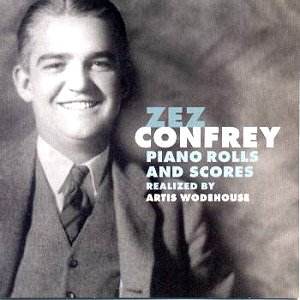Edward Elzear – better known to the world as Zez –
Confrey was born in Peru, Illinois in 1895 – hometown of another pioneering
American musician of an earlier generation, the violinist Maud Powell.
He studied at the Chicago Musical College and began work as a band pianist
before being hired in 1915 as a music demonstrator for a publishing
company – something George Gershwin incidentally was doing at pretty
much the same time. Composing prolifically he hit the big time early
with Kitten on the Keys, still the emblematic embodiment of Confrey’s
music and indeed beyond, and his other huge hit, Stumbling. At
the same time he took part in the famous Aeolian Hall concert at which
his contemporary Gershwin’s Rhapsody in Blue received its premiere.
Though he continued to compose prolifically real success never returned
to Confrey and musical fashion passed him by. He seems not to have diversified
into other forms, operetta say or musical theatre – though as one or
two of these rolls show he had an ear for impressionist devices – and
he must have seemed something of a curiosity when he died in 1971.
This Warner Classics disc is part of a series of Piano
Rolls – two volumes are devoted to Gershwin and one to the rolls of
Jelly Roll Morton. It collates the rich variety of Confrey’s output
– popular songs, ballads, parodies, novelties and his welding of ragtime
and jazz elements with bluesy inflections and impressionistic tinges.
By Confrey’s day piano rolls had evolved from the hand-punched performer-less
creation to a sophisticated mixture of performance and post-performance
"doctoring" (like a recording edit in other words). As the
notes explain making a piano roll could involve some or all of the various
mechanisms available and most would have required editing. This disc
therefore consists of rolls played by Confrey but subsequently octave
doubled or chord spread or otherwise doctored by adding extra holes
to the role to increase the complexity of the piece (and frequently
indeed to tip it over beyond the bounds of actual playability, should
one wish to replicate the roll on an ordinary piano). The primary function
of the roll, of course, was not as an archival objet d’art but
as a commercial mechanism or tool to sell sheet music to the public.
It therefore lacks, when doctored in this way, the intrinsic status
of a historical object in its own right – though it’s certainly not
without considerable interest viewed sympathetically. As an accurate
representation of a pianist’s playing it is open to serious debate but
in the case of Ampico or other rolls in classical music there are numerous
cases of pianists never having made commercial discs and these remain
the only preserved examples of their playing, however imperfect the
mechanism of recording and reproduction may be (I reviewed Fanny Bloomfield-Zeisler’s
rolls on this site not so long ago and they were fascinating).
Doubtless the manner of the realization by Artis Wodehouse
will be the subject of informed debate but I enjoyed the disc thoroughly.
Dizzy fingers is an ingenious opener and The Red Lantern
starts as a ragtime stomp before becoming graced by exotic flurries.
By the Waters of Minnetonka comes complete with jazz breaks and
cascading arpeggios but Novelette strikes another chord – this
little quasi-improvised vaguely impressionist piece reveals his debt
to Debussy, certainly, but also to that generation of American impressionists
who were so influential, such as Eastwood Lane (who also influenced
the cornettist Bix Beiderbecke, some of whose piano works bear resemblance
to Confrey’s own pieces in this style). The Waltz Mirage is a
case of those "assisted" rolls full of added notes. Greenwich
Witch, a jaunty and insouciant piece, shows the cross-pollination
between genres in American popular music and jazz in the 1920s. As Jeff
Taylor’s notes point out this was a tune quoted by the supreme jazz
piano virtuoso of the 1920s and the only pianist capable of standing
up to Louis Armstrong as an improviser, Earl Hines. It does also show
how Confrey’s music very quickly swept into the collective consciousness.
As for Kitten on the Keys there’s stride, trilling,
boogie, key changes and mobile tempo doubling jazz-style left hand.
It never fails to hit the spot. Heaven’s Garden by contrast is
a sentimental little fin de siècle tune and Humorestless
an affectionate fun-poking parody of Dvořák
(naturally). Elsewhere That Thing Called Love will bring
jazz lovers up short – the verse is the St Louis Blues (but then
W.C. Handy who wrote it or, more accurately, was given commercial credit
for it, was more an assimilator and synthesiser than an originator).
Relaxation is tinged with MacDowell tristesse and the Concert
Etude a Chopin paraphrase and not obviously motivated by humorous
intent.
There is much to enjoy in Warner’s latest roll offering.
There’s plenty of Jazz Age verve and not a little reflective nostalgia
too. I doubt you have a Pianola so this CD will do just fine.
Jonathan Woolf

